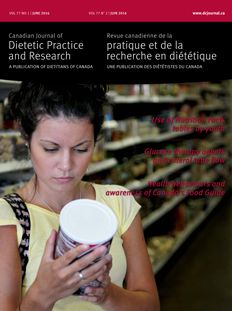Abstract
Purpose: To date, baby-led weaning (BLW) has not been examined in a Canadian population. This research investigated common BLW practices and compared associated knowledge and perceptions of practicing mothers and health care professionals (HCPs).
Methods: Sixty-five mothers practicing BLW and 33 HCPs were surveyed using 2 online questionnaires. Mothers were recruited through the Newfoundland and Labrador BLW Facebook page and HCPs via email at 2 regional health authorities.
Results: Mothers described BLW in terms of food shape and consistency (whole, solid); however, in practice, some mothers offered puréed foods such as infant cereals. More HCPs than mothers indicated choking, inadequate energy, and iron intake as concerns. Mothers relied on the Facebook page over HCPs for BLW information and support. Although all practicing mothers would recommend BLW to others, less than half (48.5%) of HCPs would support it in their practice.
Conclusions: Mothers following BLW vary greatly in their experiences and adherence to BLW. They view the practice and its disadvantages very differently than HCPs. Although most HCPs were aware of BLW, few were familiar with specific practices. HCPs may benefit from a greater understanding of BLW to provide guidance to the growing number of mothers following this practice.
Résumé
Objectif. À ce jour, le sevrage induit par le bébé (SIB) n’a jamais fait l’objet d’un examen au sein d’une population canadienne. La présente recherche s’est penchée sur les pratiques communes de SIB et a comparé les connaissances et perceptions connexes des mères s’adonnant à cette pratique et des professionnels de la santé (PS).
Méthodes. On a demandé à 65 mères pratiquant le SIB et à 33 PS de répondre à deux questionnaires en ligne. Les mères ont été recrutées par l’entremise de la page Facebook relative au SIB de Terre-Neuve-et-Labrador, et les PS, par courriel dans deux autorités sanitaires régionales.
Résultats. Les mères devaient décrire le SIB en ce qui concerne la forme et la consistance des aliments (entiers, solides). Toutefois, en pratique, les mères offraient des aliments en purée, comme des céréales pour nourrissons. Plus de PS que de mères se sont dits préoccupés par l’étouffement, l’énergie insuffisante et l’apport en fer. Les mères se tournaient vers la page Facebook, plutôt que vers les PS, pour obtenir de l’information et de l’aide au sujet du SIB. Bien que toutes les mères qui pratiquaient le SIB le recommanderaient aux autres mères, moins de la moitié (48,5 %) des PS encourageraient cette pratique.
Conclusions. L’expérience et l’adhésion relatives au SIB varient grandement entre les mères qui le pratiquent. La perception des mères quant à la pratique et à ses inconvénients est très différente de celle des PS. Bien que la majorité des PS connaissaient le SIB, très peu étaient familiarisés avec les pratiques précises. Il pourrait être à l’avantage des PS de mieux comprendre le SIB pour donner des conseils au nombre grandissant de mères qui s’adonnent à cette pratique.



